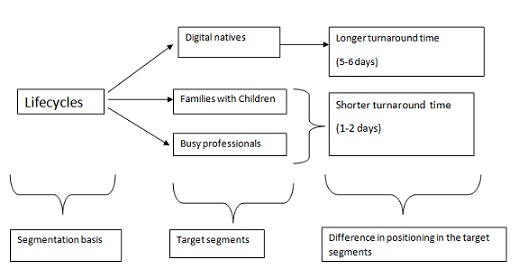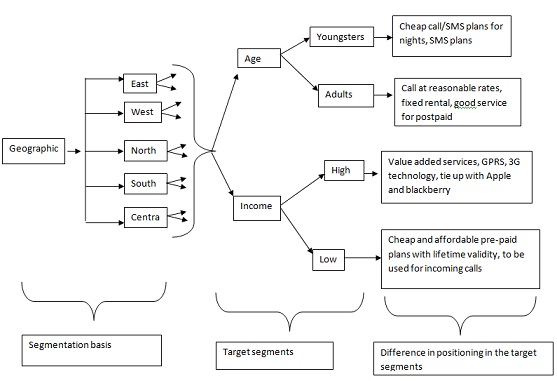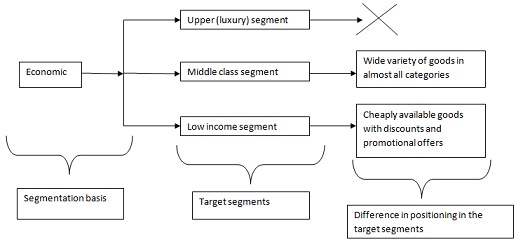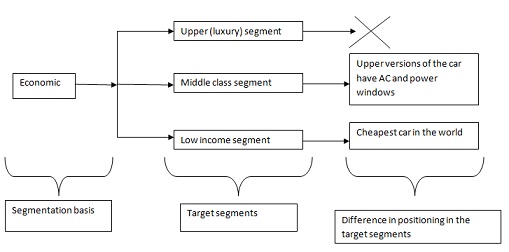Segmentation Targeting & Positioning-Defining Product Lines
When Henry Ford famously told his management team in 1909 that, “Any customer can have a car painted any color that he wants so long as it is black”, about the Model-T, little did he know that he was tinkering with human psychology that would lead to failure, instead of capitalizing on the initial success. Mr. Ford could afford the “only black” color till competition grew and eventually he had to discontinue the car after 1927. STP has since then become the cornerstone of many companies looking to launch a new product or re-define their product lines.

As the human tastes grew into more niche categories and people started looking for that “specific” product that is exactly the best one for them, the marketers dug deeper to understand the human psychology and the whole process of buying behavior. This lead to the theory of segmentation, wherein the whole market is divided into ‘segments’ to determine which kinds of customers actually exist. The segment/segments selected meticulously and then “targeted” by using various marketing tools appropriate for that category. The final stage, “positioning”, refers to the implementation plan adopted by the company to differentiate its product in the selected segment and use marketing effectively to promote it.
By this article I want to bring to focus how some companies have stupendously tapped on this marketing concept and some haven’t used it extensively which has lead to downfall. What follows is an insight on how to use it effectively.
NETFLIX
Before Netflix came into the DVD rental business in the US, the DVD rental outlets were huge business. It was almost a monopoly for the kiosk DVD retailers and the hefty fine charged for late return from Reed Hastings lead him to conceive this idea. By 2010, Netflix was earning revenues worth $2.16billion, almost crowding out all of the come and take home business. Netflix revolutionized the idea of DVD rentals by accepting orders online and shipping the DVDs to their homes. What industry observers believe is a brilliant marketing strategy from Netflix, the company knows exactly how to segment their market and target those customers which will bring maximum profits for them.
It extensively advertises to attract the customers who watch the fewest movies and hence bring maximum profits to them. It has segmented the market into classes depending on lifecycle and the social class mainly. It targets ‘digital natives’, families with children and working busy professionals. By extensive advertising in entertainment and parenting magazines, it attracts customers which yield the maximum profit and provides superior services to these customers (like quick turnaround time), in order to reap maximum benefit. With over 15 million registered users, Netflix continues to give a hard time to Blockbuster and Amazon.

AIRTEL
Good use of marketing strategy is well represented by the example of Airtel in India. India is the world’s fastest growing telecom market, and has one of the largest mobile phone subscribers in the world. A slew of mobile services companies have cropped up, but Airtel continues to remain a dominant player in the market with the maximum market share.
Airtel meticulously segments its market. Apart from the geographic segmentation, which divides the Indian market into east, west, south, north and central regions, the market is also segmented in each region on the basis of age and income. The different geographic regions are handled independently and different campaigns are run according to the tastes and preferences of people in each region. Under each region, age and income play an important role in determining the extent of mobile usage.
Hence Airtel caters to two different categories each in age and income. It targets younger population by providing them cheap call/msg rates at night and also cheap SMS plans, while the elder population is targeted by plans for calls at reasonable rates. In the income categories, the lower income people are targeted by offering them cheap and affordable lifetime validity prepaid cards, that can be used for incoming calls; while the higher income groups are targeted by offering them premium services like VAS(value added services), GPRS plans and 3G technology.

BIG BAZAAR
Big Bazaar (large market) has lead to a revolution in retail sales in not only metro cities, but also tier 1 and 2 cities. Till, 2000 the share of organized retail in India was about 0.9%, which increased to 3.5% in 2003 and was about 12% in 2010. Big Bazaar reaped huge benefits in this expansion of organized retail in the country. But much of its success is attributed to its unique and innovative marketing strategy involved in the process. Big Bazaar’s parent company, Pantaloon Retail India Limited (PRIL) considered itself a classless retailer and hence hasn’t tried much to segment the market and appeals to all demographic and socio-economic segments in the market.
Big Bazaar entered the market with large hypermarket stores with a touch of “Indianness”. They wanted to attract consumers who hitherto went to local kirana stores for their daily purchases. To persuade the customers, Big Bazaar incorporated elements of the bazaar experience into its stores. For example, the Indian customers like touching and feeling certain products before making a purchase, hence Big Bazaar had loose grains which they would touch and feel.
Addressing the second major concern, the customers are extremely price sensitive and feel that organized stores charge a premium on products. Dispelling their fears, Big Bazaar promoted its stores by a tagline “isse sasta aur accha kahin nahin” (nowhere a cheaper and a better quality bargain), which drove normal middleclass customers in hordes to the stores. While all this lead to instant success, a no STP use also lead to a loss of a major opportunity, which now the PRIL management is frowning upon.
In vowing middle class customers from all segments, Big Bazaar lost out on the very important segment of upper class customers, which provide the maximum revenue to any business, due to the high premium on high class goods. With the entry of Reliance in retail and the pending legislation on FDI in multi brand retail, it faces tough competition ahead. The profit margin in middle segment goods is very less and hence the exclusion of luxury/upper class segment would hurt Big Bazaar in the long run.

TATA NANO
Another example to suggest an incorrect way of using the STP model is the example of the Nano can in India. Nano was launched amidst much fan fare in the Delhi Auto Expo in 2008 with the tag of being the cheapest car in the world. With such an attempt, Tata tried to target the lower end two wheeler driving population, expecting them to upgrade to the next available option.
Tata tried various moves so that the car appeals to the lower classes, such as displaying them in the super markets and adding hybrid and diesel variants, the Nano continues to upset all sales predictions. It seems the lower income masses of India do not want the stigma of owning the cheapest car in the world. Many of them interviewed say they will stretch their budget while making a purchase just so that they do not have to say they have the Nano. According to business experts, Nano’s biggest problem should have been easy to see: Nobody wants a car whose primary attribute is that it is cheap.

CONCLUSION:
As observed from the examples above, a correctly used STP model leads to a sustainable model of success. On the other hand, an incorrect and/or incomplete use of the STP model will almost surely endanger the long term prospects of any product in any market. Exclusion of any particular segment from the initial concept might lead to problems later hence it is beneficial to make an informed decision while developing and launching a product. It is essential to understand the entire customer market and use the STP model appropriately to fully benefit from the unique proposition of a product concept.
This article has been authored by Anurag Gupta from IIM Indore.
Image: FreeDigitalPhotos.net
Views expressed in the article are personal. The articles are for educational & academic purpose only, and have been uploaded by the MBA Skool Team.
If you are interested in writing articles for us, Submit Here
Share this Page on:
What is MBA Skool?About Us
MBA Skool is a Knowledge Resource for Management Students, Aspirants & Professionals.
Business Courses
Quizzes & Skills
Quizzes test your expertise in business and Skill tests evaluate your management traits
All Business Sections
Write for Us